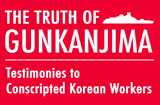
"A Shameful World Cultural Heritage - Gunkanjima"
This is a picture book for children published in Korea. Led by a butterfly, the main character who visited Gunkanjima (the Battleship Island) met Korean boys who used to live there in those days. It depicts a tragic story of little Korean boys who were forcefully taken to Gunkanjima, trapped in iron bars, forced to do arduous work in the underground coal mine, abused, tortured and killed in an explosion accident. The postscript says that the boys were starved to death and that “we must correctly understand our history.” Did something like this really take place in Gunkanjima? We interviewed the former Hashima Islanders.
CLAIM
"A Shameful World Cultural Heritage - Gunkanjima"
Words and Pictures by Mun Young Lee
Published by Uri Kyouiku 2016
Japan, in the crazed clutches of war, conscripted even young Korean boys to work in Japan."A Shameful World Cultural Heritage - Gunkanjima" Topics 8
“Let's escape.Rather than being killed in a cave-in mining coal, I'd rather die drowning in the ocean attempting to escape!""A Shameful World Cultural Heritage - Gunkanjima" Topics 20
Comrades would sneak by the guards, and climb over the seawall.
The Japanese guards used whips to beat people, drawing blood and tearing flesh."A Shameful World Cultural Heritage - Gunkanjima" Topics 16
Countless night-long torture sessions left people's minds and bodies in tatters."A Shameful World Cultural Heritage - Gunkanjima" Topics 22
DISPROOF
Verification1 Were young boys subject to forced labor?
Verification2 Was There a Searchlight?
Verification3 Was There Torture?
Testimony: Hashima Islanders for Historical Truth
Isamu Sasayama, Hiroshi Moriyasu, Manabu Matsumoto,
Tomohiro Tada, Mitsuoki Tsubouchi, Hiroyasu Honma, Harue Kobayashi
This picture book depicts a story of 12-year-old boys who were forcibly taken to Gunkanjima and had to dig coals 1,000 meters below ground. However, since it was legally prohibited to employ minors under the age of 14 and to have minors under the age of 16 work inside a pit in Japan at that time, such a description is incorrect. Similarly, since the depth of the mining gallery then was just over 710 meters, it was not possible to work 1,000 meters below ground. Although the book says, “Another died. Another fellow worker died.”, “There were a number of boys who threw themselves to the sea”, “The boys were starved to death while performing arduous work in the underground coal mine”, there was not a single record of boys under the age of 18 dying inside a pit according to death records of Koreans in Hashima for 20 years.


